Read. Imagine. Travel.
Namaste!
Many people ask what is closer to India's enigmatic picture: the culture, the villages, or the people? There is no wrong answer to it. For some, culture is the most mysterious thing. For others, it is the people. There is one thing about India, which is far more vibrant, diverse, away from the modern trends, and economic development - the Adivasis (or the tribes). Their languages, religious beliefs, festivals and celebrations, music, way of life, hospitality, dance, and cuisines are so different from the rest of India that India's visit is incomplete without having a glimpse of their life.
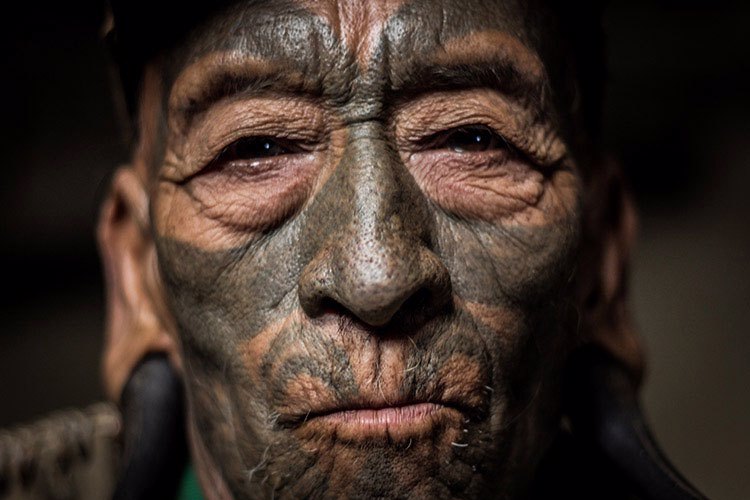
After exhaustive research, we can say that India has more than 500 tribal communities, which comprise around 8.6% of India's population (as per the census done by the Government of India in 2011). India's tribal community's lively tableau occupies the remote villages tucked in the Great Himalayan region to India's southernmost tip and from the desert of Rajasthan to the farthest corner of North East India.
It does not matter which part of India you choose. Be it a trekking tour in the Indian Himalayan region or a beach holiday in Kerala or Goa, you surely will get an impression of some of the tribes dwelling in the region.
Now let us see the real picture of the major Tribes of India:
1. Bhil Tribes
Rajasthan, the land of Forts and Palaces, is one of the most visited states of India. However, if you move a little away from the grand forts and palaces, then you will discover the lifestyle of the Bhil tribes in its absolute contrast. The Bhil tribe mostly lives in the Aravali Ranges of Sirohi in Udaipur and some other areas of Rajasthan such as the Banswara and Dungarpur districts. Further, these tribal settlements of the Bhil tribes are also found in some parts of Madhya Pradesh, Maharashtra, Tripura, and Gujarat.
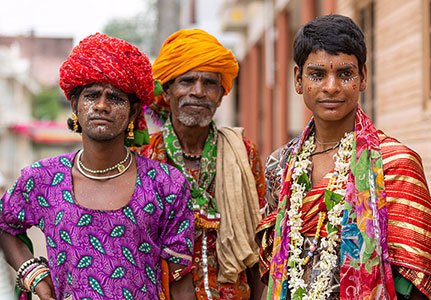 So the real question is – What to experience? The simple answer is the cultural richness and the famous Ghoomar dance, the Baneshwar Fair held in January or February, where the Than Gair, a religious dance and drama, is performed.
So the real question is – What to experience? The simple answer is the cultural richness and the famous Ghoomar dance, the Baneshwar Fair held in January or February, where the Than Gair, a religious dance and drama, is performed.
The other very interesting and intriguing experience of visiting the Bhili tribe is their language, which is an Indo – Aryan language !.
2. Gond Tribes
Gond Tribes are majorly found in the Chhindwara district of Madhya Pradesh, which is around 80 kms from one of the famous national parks of Madhya Pradesh - the Pench National Park. A relatively small percentage of the Gond tribe is also found in the Bastar district in Chhattisgarh, Orissa, Andhra Pradesh, and Maharashtra.
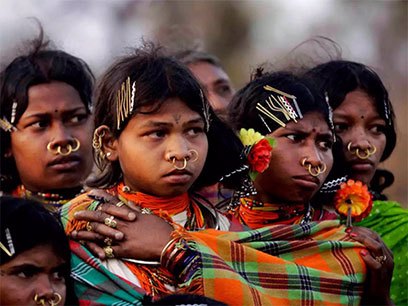
So when you are visiting the national parks of Madhya Pradesh, pondering over the titillating sculptures of Khajuraho, or finding peace at Sanchi Stupa, drive towards the Gondi forest to experience the vibrant lifestyle of the Gonds. Take a drive to Gonds people of the Indian tribe in this video.
The intriguing tradition of Gonds is called Pethu, or live-in relationships which is quite popular here, with many couples marrying after their children's birth. Unlike what we know about the Indian culture being traditional and conservative in terms of marriages, among the Gonds of Bastar region in Chhattisgarh, this tradition is accepted and couples are not ostracized. Nothing like the notion of the Indian culture, Right?
What to experience? The mud walls and thatched roof houses with rural colours, traditional wears – Dhoti (a long loincloth) for men and Sari for women, ornaments, earthen pots, ritual performances, and the festivals of Keslapur Jathra and Madai are some of the experiences you should not miss. While you visit them, do try the Gond's staple food: the Kodo or Kutki.
3. Santhal Tribes
One of the major tribes of West Bengal, the Santhal tribes, is mostly seen in Bankura and Purulia's districts. They are also seen in some parts of Jharkhand, Bihar, Assam, and Odisha. To reach Santhals' dwellings, you will have to start your journey from India's cultural capital, Kolkata.
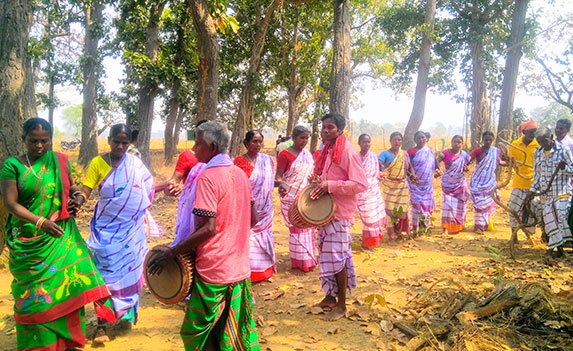
During this epic journey, you will have an opportunity to see some of the finest terracotta temples at Bishnupur and Bolpur. Most of the Santhals largely depend upon agriculture and livestock. They are also masters in the art of hunting.
What to experience? During your visit, you just cannot miss out on the Santhali dance and music, which are the major attractions of these amazing tribal people. Festivals like Maghe, Karam, Sahrai, Baba Bonga, Namah, Asaria, Ero, and Disum Sendra often fascinate travellers.
|
4. Khasi Tribes
 If you thought of seeking to discover a culture hidden in the mysterious mountains of Meghalaya, the ethnic tumult of the Khasi tribes, which is filled with lots of musical instruments like guitars, flutes, drums, wooden pipes, and metal cymbals, plan your trip to bright and striking Meghalaya.
If you thought of seeking to discover a culture hidden in the mysterious mountains of Meghalaya, the ethnic tumult of the Khasi tribes, which is filled with lots of musical instruments like guitars, flutes, drums, wooden pipes, and metal cymbals, plan your trip to bright and striking Meghalaya.
The Khasi tribes are majorly concentrated in the Khasi Hills and are also found in some parts of West Bengal, Arunachal Pradesh, Assam, and Manipur. What to experience? Other than the Austroasiatic language and the most colourful dress, the other treat for you is the five-day long extravaganza, the Nongkrem festival.
5. Garo Tribes
One of the few remaining matrilineal societies globally, mostly spotted in Meghalaya's hills, the Garo Tribes, is ideal for their vivid lifestyle. They are also spotted in the neighbouring country Bangladesh and a few parts of Assam, West Bengal, and Nagaland. It is rather easy to recognize the Garo tribes and distinguish them from other tribes living in Meghalaya. The Khasi women are often seen sporting their traditional ornaments. On the other hand, men are seen sporting turbans with feathers stuck behind their heads.
 What else to experience? Garo's unique architectural forms like Nokmong, Nokpante, Jamsireng, and Jamadaal are abstract to be captured in your lens. One thing that you cannot miss about this amazing tribe is the Wangala festival of Asanang.
What else to experience? Garo's unique architectural forms like Nokmong, Nokpante, Jamsireng, and Jamadaal are abstract to be captured in your lens. One thing that you cannot miss about this amazing tribe is the Wangala festival of Asanang.
6. Angami Tribes
You must have heard of the famous Hornbill Festival held in Nagaland every year in the first week of December. It is the Angami Naga tribes that have been pulling travellers to this beautiful Hornbill Festival for years. The Angami Nagas are widely present in Kohima and are considered one of the major tribes living in Nagaland. Apart from the Hornbill Festival, the other major attraction remains their elaborate and exquisite woodcraft and artwork. The Angami Nagas are known for bamboo work, cane furniture, beds, shawls, and powerful machetes.
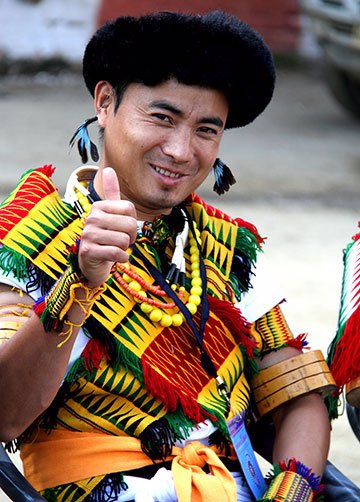 What else to experience? Their dressing style – white Mhoushu and black Lohe for men and Mechala along with ornaments like beads for women, miniature mask pendants, bangles, and bracelets sported by women, will surely attract your eyes. The Angami language identified with different names such as Gnamei, Ngami, Tsoghami, and Monr, is another major hallmark of The Khasi to get hold off. If you love meat, you would love some of the unique pork dishes made in the Angami Nagas' kitchens. Enjoy Angami folk dance performance in this short video.
What else to experience? Their dressing style – white Mhoushu and black Lohe for men and Mechala along with ornaments like beads for women, miniature mask pendants, bangles, and bracelets sported by women, will surely attract your eyes. The Angami language identified with different names such as Gnamei, Ngami, Tsoghami, and Monr, is another major hallmark of The Khasi to get hold off. If you love meat, you would love some of the unique pork dishes made in the Angami Nagas' kitchens. Enjoy Angami folk dance performance in this short video.
7. Bhutia Tribes
Dominating Sikkim's landlocked territory bordered by the Indian Himalayas, the Bhutias are widely known for their traditional grandeur, art, and cuisine.
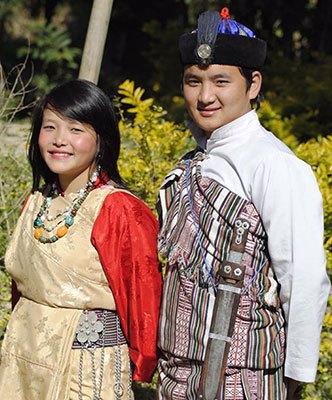 One cannot forget momo's unique preparation of slurpy, burpy, and yummy thukpa and the steamed meat dumplings. If you visit Sikkim and would love to see the Bhutias in their full glory, plan your trip during the Losar and Loosong festival. These festivals' experience is surreal, and the vivid culture – dance, music, and religion will take you all together to a different zone. The hardcore meat lovers can try some of the spicy beef fresh out of the Bhutia's kitchen.
One cannot forget momo's unique preparation of slurpy, burpy, and yummy thukpa and the steamed meat dumplings. If you visit Sikkim and would love to see the Bhutias in their full glory, plan your trip during the Losar and Loosong festival. These festivals' experience is surreal, and the vivid culture – dance, music, and religion will take you all together to a different zone. The hardcore meat lovers can try some of the spicy beef fresh out of the Bhutia's kitchen.
8. Chenchu Tribes
The Chenchu tribes are found mostly in Andhra Pradesh and Telangana, inhabiting indigenous people over the years in the Nallamala Hill's forest area. They are mostly seen in the districts of Mahboobnagar, Nalgonda, Prakasam, Guntur, and Kurnool. Life is hard for them as they are largely dependent on hunting and trading jungle products like roots, tubers, fruits, tendu leaves (for making local cigarettes), mahua flowers, honey, gum, tamarind, and green leaves.
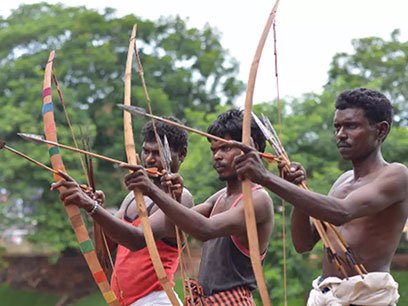 What to experience? Other than their language having the Telugu accent, they are skilled in various arts and crafts. Further, the Chenchu tribes are extremely ritualistic. Their ritual performances of various gods and goddesses are the major attractions for travellers.
What to experience? Other than their language having the Telugu accent, they are skilled in various arts and crafts. Further, the Chenchu tribes are extremely ritualistic. Their ritual performances of various gods and goddesses are the major attractions for travellers.
9. Kodava Tribes
When you move away from Mysore on the Madikeri Road, you are slowly driving to the home of one of India's distinct races, the Kodava tribes, known for their bravery for ages. Coorg, flourishing as one of India's most sought-after eco-tourist destinations, is also the hub for coffee and spice plantations and attracts many travellers from around the globe. The harmony and ethnicity of the Kodava tribes are the things to be admired. Visit their home for a meal and dig into the cultural perspective of the Kodava tribes. The Kodava tribe is really fond of their music and dance, which one can witness in their day-to-day lives.
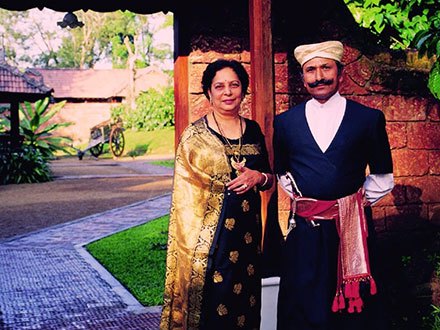 Further such hues expand exponentially during their festivals such as Puttari, Kaveri Sankramana, and Kailpodhu. If you visit the "Scotland of India" - Coorg, be sure to enjoy the amazing warmth and hospitality of hotels Coorg International and Heritage Resort Coorg.
Further such hues expand exponentially during their festivals such as Puttari, Kaveri Sankramana, and Kailpodhu. If you visit the "Scotland of India" - Coorg, be sure to enjoy the amazing warmth and hospitality of hotels Coorg International and Heritage Resort Coorg.
10. Irula Tribes
Expert snake and rat catchers, that's what makes the Irula tribes of South India special. With approximately 3,00,000 in number, the Irulas inhabit Kerala, Karnataka, Tamil Nadu, and some parts of Andhra Pradesh. Further, in Kerala, the Irulas are the second largest tribe and are mostly seen in the Palakkad district, famous for natural geographical bounties starting from lush green plains to tall mountains in the western ghats. When you are on holiday in Kerala to enjoy the Nilgiri Mountain's sprawling hues and cruising down on the famous houseboats on the Backwaters of Alleppey, steer away for a day to Palakkad.
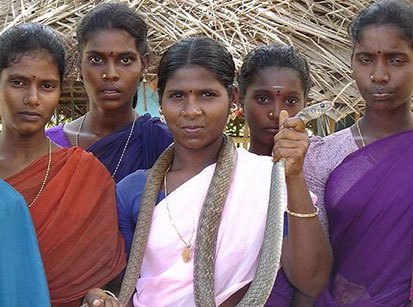 What to experience? Since the Irulas are mostly dependent on agricultural products, a visit to their home will give you an opportunity to see their life from very closed quarters. The other attraction is their varied ritual performances. Although most of them are Hindus, they still believe in worshipping their own diety.
What to experience? Since the Irulas are mostly dependent on agricultural products, a visit to their home will give you an opportunity to see their life from very closed quarters. The other attraction is their varied ritual performances. Although most of them are Hindus, they still believe in worshipping their own diety.
11. Nyishi Tribes
The Nyishi tribes are the most populous settlers in the mountainous state of Arunachal Pradesh. While a majority of them have converted to Christianity, their religion still involves a belief in spirits associated with nature. What to experience? The Nyokum Festival, which is dedicated to the goddess Nyokum, held in February, is a major attraction where you, as a traveller, can be a witness to the interesting cultural heritage and ethnicity of the Nyishi tribes. The word 'Nyokum' comes from two words - "Nyok," which means "land or earth," and "Kum," which means togetherness.
 That is perhaps why the festival is considered similar to inviting the Gods and Goddesses to the land of the living. This beautiful festival is celebrated to invoke the spiritual forces to ensure the prosperity and harmony of the people who observed it.
That is perhaps why the festival is considered similar to inviting the Gods and Goddesses to the land of the living. This beautiful festival is celebrated to invoke the spiritual forces to ensure the prosperity and harmony of the people who observed it.
12. Bodo Tribes
The Bodo Tribes are considered to be among the early settlers of the northeastern state of Assam. Today they are found in Udalguri and Kokrajhar of Assam and in some parts of West Bengal and Nagaland. If you are keen to seek the Bodo people's traditional colours, then travel to North East India during the Baishagu Festival, dedicated to Lord Shiva (locally known as Bathou), celebrated during the spring season every year.
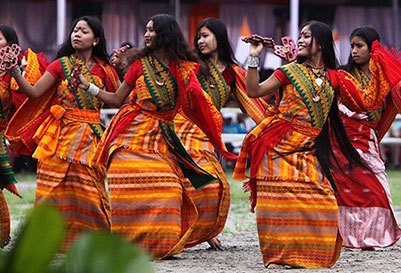 Further, the Bodo tribes are meat-eating people, and during your visit, you must try out some unique preparation of pork and fish. What else to experience? Weaving is one of the most intrinsic parts of Bodo culture, and hence you can buy some handloom products.
Further, the Bodo tribes are meat-eating people, and during your visit, you must try out some unique preparation of pork and fish. What else to experience? Weaving is one of the most intrinsic parts of Bodo culture, and hence you can buy some handloom products.
13. Warli Tribes
Scattered around the states of Maharashtra and Gujarat, The Warli or Varli tribes display a form that is both unique and intriguing. The art and painting of the Warli Tribe reflect the mural paintings carved in the Rock Shelters of Bhimbetka Madhya Pradesh, which were carved between 500 – 10,000 BC.
 Their art form follows the rudimentary technique with a mixture of cow dung and earth, bamboo sticks, branches, rice paste, red ochre, and many more. If you want to seek such grandeur, visit the Warli Folk Art Dancing People Festival, held in March every year. Don't miss the Tarpa Dance, a folk dance performed during the harvest season.
Their art form follows the rudimentary technique with a mixture of cow dung and earth, bamboo sticks, branches, rice paste, red ochre, and many more. If you want to seek such grandeur, visit the Warli Folk Art Dancing People Festival, held in March every year. Don't miss the Tarpa Dance, a folk dance performed during the harvest season.
14. Toda Tribes
Toda Tribes dominate parts of the Nilgiri Mountains. They are largely dependent on cattle-herding and dairy work. They are also skilled in architecture and artwork, such as the embroidery work.
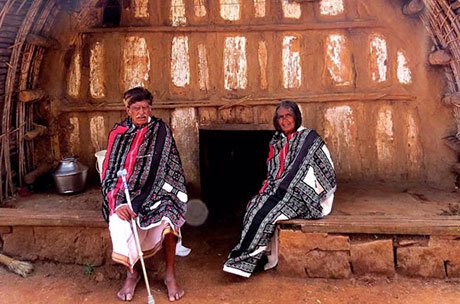 These amazing people have elaborate huts made to serve as their temples. If you are travelling to Ooty, one of the popular hill stations in Tamil Nadu, be sure to visit the Toda huts and people inhabiting the area. Know more about the Toda Tribes in this video.
These amazing people have elaborate huts made to serve as their temples. If you are travelling to Ooty, one of the popular hill stations in Tamil Nadu, be sure to visit the Toda huts and people inhabiting the area. Know more about the Toda Tribes in this video.
15. Dard Aryan Tribes
The Himalayas are an abode of various tribes. Among the various races, the " Dard Aryan Tribe" originally from Central Asia and came to India via Gilgit and settled in various parts of Ladakh and Kashmir. The Aryan valley is famous for its culture, traditions language and their looks are different from other descendants of Ladakh.
 Historians called the people (some community) of Dhahanu, Garkon, Darchik, Chulichan, Sharchey and Karkit-Budgam, Kaksar, Chandigund & Drass as the Dard Aryan. The word "Dard" is derived from Sanskrit word Daradas which means "People who live on hill sides".
Historians called the people (some community) of Dhahanu, Garkon, Darchik, Chulichan, Sharchey and Karkit-Budgam, Kaksar, Chandigund & Drass as the Dard Aryan. The word "Dard" is derived from Sanskrit word Daradas which means "People who live on hill sides".
16. Bhoi Tribes
Also, known as the village of silk weavers, Umden is located in the Ri Bhoi district amid lush greenery and at a distance of around 65 km from Shillong.
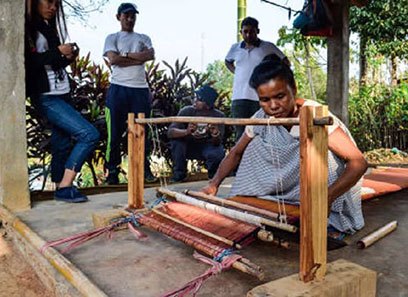 Inhabited by the Bhoi tribe, who are known for their expertise in weaving traditional handlooms, this is also where you can learn the process of silk production, and how it is used to produce beautiful handicrafts.
Inhabited by the Bhoi tribe, who are known for their expertise in weaving traditional handlooms, this is also where you can learn the process of silk production, and how it is used to produce beautiful handicrafts.
The weavers don’t kill the silk worms during the process, as the villagers follow ahimsa (non-violence) tradition of sericulture. Apart from that, the village has some really good short hikes around.
So next time you are planning a trip to India, do let your clients know about the beautiful tribes of India. This will give your clients a perfect way to know Indian culture, meet beautiful people and capture the essence of India in their lens. Select any of the regions in India, and we are sure your clients will just love meeting these lovely people!! We, at Indo Asia Tours, are all about the handcrafted tours, memories, and moments you take out of your trip, and believe us, this escapade will be a life-changing one!
|
Virtual Destination Training Program
|
 Thank you, patrons, for reposing faith in our destinations and enquiring for customised virtual destination awareness training programs. We are proud to conduct them successfully so far and are looking forward to hold similar virtual destination awareness training programs for your team or yourself or a virtual tour for your clients. Let us know the destination of your interest along with your convenient date / time and we will be happy to set up a program for you.
Thank you, patrons, for reposing faith in our destinations and enquiring for customised virtual destination awareness training programs. We are proud to conduct them successfully so far and are looking forward to hold similar virtual destination awareness training programs for your team or yourself or a virtual tour for your clients. Let us know the destination of your interest along with your convenient date / time and we will be happy to set up a program for you.
Send Request
|
Please feel free to write back to us at marketing@indoasiatours.com to share our thoughts on customized journeys covering the Indian subcontinent or take time to visit our website https://www.indoasia-tours.com. Be sure we will prepare the best program to make a memorable trip for your esteemed clients!
|
|


 So the real question is – What to experience? The simple answer is the cultural richness and the famous Ghoomar dance, the Baneshwar Fair held in January or February, where the Than Gair, a religious dance and drama, is performed.
So the real question is – What to experience? The simple answer is the cultural richness and the famous Ghoomar dance, the Baneshwar Fair held in January or February, where the Than Gair, a religious dance and drama, is performed.
 So when you are visiting the national parks of Madhya Pradesh, pondering over the titillating sculptures of Khajuraho, or finding peace at Sanchi Stupa, drive towards the Gondi forest to experience the vibrant lifestyle of the Gonds.
So when you are visiting the national parks of Madhya Pradesh, pondering over the titillating sculptures of Khajuraho, or finding peace at Sanchi Stupa, drive towards the Gondi forest to experience the vibrant lifestyle of the Gonds.  During this epic journey, you will have an opportunity to see some of the finest terracotta temples at Bishnupur and Bolpur. Most of the Santhals largely depend upon agriculture and livestock. They are also masters in the art of hunting.
During this epic journey, you will have an opportunity to see some of the finest terracotta temples at Bishnupur and Bolpur. Most of the Santhals largely depend upon agriculture and livestock. They are also masters in the art of hunting.
 If you thought of seeking to discover a culture hidden in the mysterious mountains of Meghalaya, the ethnic tumult of the Khasi tribes, which is filled with lots of musical instruments like guitars, flutes, drums, wooden pipes, and metal cymbals, plan your trip to bright and striking Meghalaya.
If you thought of seeking to discover a culture hidden in the mysterious mountains of Meghalaya, the ethnic tumult of the Khasi tribes, which is filled with lots of musical instruments like guitars, flutes, drums, wooden pipes, and metal cymbals, plan your trip to bright and striking Meghalaya.
 What else to experience? Garo's unique architectural forms like Nokmong, Nokpante, Jamsireng, and Jamadaal are abstract to be captured in your lens. One thing that you cannot miss about this amazing tribe is the Wangala festival of Asanang.
What else to experience? Garo's unique architectural forms like Nokmong, Nokpante, Jamsireng, and Jamadaal are abstract to be captured in your lens. One thing that you cannot miss about this amazing tribe is the Wangala festival of Asanang.
 What else to experience? Their dressing style – white Mhoushu and black Lohe for men and Mechala along with ornaments like beads for women, miniature mask pendants, bangles, and bracelets sported by women, will surely attract your eyes. The Angami language identified with different names such as Gnamei, Ngami, Tsoghami, and Monr, is another major hallmark of The Khasi to get hold off. If you love meat, you would love some of the unique pork dishes made in the Angami Nagas' kitchens.
What else to experience? Their dressing style – white Mhoushu and black Lohe for men and Mechala along with ornaments like beads for women, miniature mask pendants, bangles, and bracelets sported by women, will surely attract your eyes. The Angami language identified with different names such as Gnamei, Ngami, Tsoghami, and Monr, is another major hallmark of The Khasi to get hold off. If you love meat, you would love some of the unique pork dishes made in the Angami Nagas' kitchens.  One cannot forget momo's unique preparation of slurpy, burpy, and yummy thukpa and the steamed meat dumplings. If you visit Sikkim and would love to see the Bhutias in their full glory, plan your trip during the Losar and Loosong festival. These festivals' experience is surreal, and the vivid culture – dance, music, and religion will take you all together to a different zone. The hardcore meat lovers can try some of the spicy beef fresh out of the Bhutia's kitchen.
One cannot forget momo's unique preparation of slurpy, burpy, and yummy thukpa and the steamed meat dumplings. If you visit Sikkim and would love to see the Bhutias in their full glory, plan your trip during the Losar and Loosong festival. These festivals' experience is surreal, and the vivid culture – dance, music, and religion will take you all together to a different zone. The hardcore meat lovers can try some of the spicy beef fresh out of the Bhutia's kitchen.
 What to experience? Other than their language having the Telugu accent, they are skilled in various arts and crafts. Further, the Chenchu tribes are extremely ritualistic. Their ritual performances of various gods and goddesses are the major attractions for travellers.
What to experience? Other than their language having the Telugu accent, they are skilled in various arts and crafts. Further, the Chenchu tribes are extremely ritualistic. Their ritual performances of various gods and goddesses are the major attractions for travellers.
 Further such hues expand exponentially during their festivals such as Puttari, Kaveri Sankramana, and Kailpodhu. If you visit the "Scotland of India" - Coorg, be sure to enjoy the amazing warmth and hospitality of hotels Coorg International and Heritage Resort Coorg.
Further such hues expand exponentially during their festivals such as Puttari, Kaveri Sankramana, and Kailpodhu. If you visit the "Scotland of India" - Coorg, be sure to enjoy the amazing warmth and hospitality of hotels Coorg International and Heritage Resort Coorg.
 What to experience? Since the Irulas are mostly dependent on agricultural products, a visit to their home will give you an opportunity to see their life from very closed quarters. The other attraction is their varied ritual performances. Although most of them are Hindus, they still believe in worshipping their own diety.
What to experience? Since the Irulas are mostly dependent on agricultural products, a visit to their home will give you an opportunity to see their life from very closed quarters. The other attraction is their varied ritual performances. Although most of them are Hindus, they still believe in worshipping their own diety.
 That is perhaps why the festival is considered similar to inviting the Gods and Goddesses to the land of the living. This beautiful festival is celebrated to invoke the spiritual forces to ensure the prosperity and harmony of the people who observed it.
That is perhaps why the festival is considered similar to inviting the Gods and Goddesses to the land of the living. This beautiful festival is celebrated to invoke the spiritual forces to ensure the prosperity and harmony of the people who observed it.
 Further, the Bodo tribes are meat-eating people, and during your visit, you must try out some unique preparation of pork and fish. What else to experience? Weaving is one of the most intrinsic parts of Bodo culture, and hence you can buy some handloom products.
Further, the Bodo tribes are meat-eating people, and during your visit, you must try out some unique preparation of pork and fish. What else to experience? Weaving is one of the most intrinsic parts of Bodo culture, and hence you can buy some handloom products.
 Their art form follows the rudimentary technique with a mixture of cow dung and earth, bamboo sticks, branches, rice paste, red ochre, and many more. If you want to seek such grandeur, visit the Warli Folk Art Dancing People Festival, held in March every year. Don't miss the Tarpa Dance, a folk dance performed during the harvest season.
Their art form follows the rudimentary technique with a mixture of cow dung and earth, bamboo sticks, branches, rice paste, red ochre, and many more. If you want to seek such grandeur, visit the Warli Folk Art Dancing People Festival, held in March every year. Don't miss the Tarpa Dance, a folk dance performed during the harvest season.
 These amazing people have elaborate huts made to serve as their temples. If you are travelling to Ooty, one of the popular hill stations in Tamil Nadu, be sure to visit the Toda huts and people inhabiting the area.
These amazing people have elaborate huts made to serve as their temples. If you are travelling to Ooty, one of the popular hill stations in Tamil Nadu, be sure to visit the Toda huts and people inhabiting the area.  Historians called the people (some community) of Dhahanu, Garkon, Darchik, Chulichan, Sharchey and Karkit-Budgam, Kaksar, Chandigund & Drass as the Dard Aryan. The word "Dard" is derived from Sanskrit word Daradas which means "People who live on hill sides".
Historians called the people (some community) of Dhahanu, Garkon, Darchik, Chulichan, Sharchey and Karkit-Budgam, Kaksar, Chandigund & Drass as the Dard Aryan. The word "Dard" is derived from Sanskrit word Daradas which means "People who live on hill sides".
 Inhabited by the Bhoi tribe, who are known for their expertise in weaving traditional handlooms, this is also where you can learn the process of silk production, and how it is used to produce beautiful handicrafts.
Inhabited by the Bhoi tribe, who are known for their expertise in weaving traditional handlooms, this is also where you can learn the process of silk production, and how it is used to produce beautiful handicrafts.
 Thank you, patrons, for reposing faith in our destinations and enquiring for customised virtual destination awareness training programs. We are proud to conduct them successfully so far and are looking forward to hold similar virtual destination awareness training programs for your team or yourself or a virtual tour for your clients. Let us know the destination of your interest along with your convenient date / time and we will be happy to set up a program for you.
Thank you, patrons, for reposing faith in our destinations and enquiring for customised virtual destination awareness training programs. We are proud to conduct them successfully so far and are looking forward to hold similar virtual destination awareness training programs for your team or yourself or a virtual tour for your clients. Let us know the destination of your interest along with your convenient date / time and we will be happy to set up a program for you.



